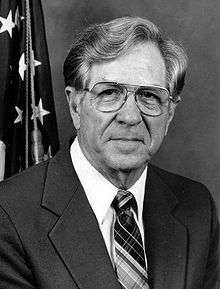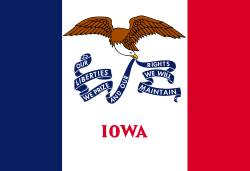Neal Edward Smith
| Neal Edward Smith | |
|---|---|
 | |
| Member of the U.S. House of Representatives from Iowa's 4th district | |
|
In office January 3, 1973 – January 3, 1995 | |
| Preceded by | John H. Kyl |
| Succeeded by | Greg Ganske |
| Member of the U.S. House of Representatives from Iowa's 5th district | |
|
In office January 3, 1959 – January 3, 1973 | |
| Preceded by | Paul Cunningham |
| Succeeded by | William J. Scherle |
| Personal details | |
| Born |
March 23, 1920 Hedrick, Iowa |
| Political party | Democratic Party |
| Spouse(s) | Beatrix Havens |
Neal Edward Smith (born March 23, 1920) was a member of the United States House of Representatives from Iowa from 1959 until 1995—the longest-serving Iowan in the United States House of Representatives. He was born in his grandparents' home near Hedrick, Keokuk County, Iowa. He served in the United States Army Air Forces during the Second World War as a bomber pilot. His plane was shot down and he received a Purple Heart, nine Battle stars, and the Air Medal with four oak leaf clusters. He received his undergraduate training at the University of Missouri and Syracuse University and received a law degree from Drake University in 1950. He was elected to the House of Representatives in the Democratic landslide of 1958, and was reelected 17 more times from a district based in Des Moines--numbered as the 5th District from 1959 to 1973 and as the 4th District from 1973 to 1995.
A federal anti-nepotism law, sponsored by Smith, was enacted in 1967 prevents public officials, including the president, from appointing any relative to head an executive agency. When the law was passed in 1967, it was presumed to be a congressional response to U.S. President John F. Kennedy appointing his younger brother, Robert Kennedy, as U.S. attorney general. As the author of the bill, however, Smith repeatedly denied this was his motive. Smith instead aimed the legislation, the Federal Postal Act of 1967, at nepotism in the postal service, and it applied broadly to both the executive and legislative branches. He said it applied to Congress because “there were 50 members who had their wives on the payrolls.”
For most of his tenure, Smith represented a relatively compact district in central Iowa. However, the 1990s redistricting pushed him into a district covering the southwest quadrant of the state from Des Moines to Council Bluffs, an area that he did not know and that did not know him. He was defeated in the Republican landslide of 1994 by Greg Ganske, mainly due to heavy losses in the western portion of the district.
Neal Smith married Beatrix Havens and had two children, Doug and Sharon.
The Neal Smith Wildlife Refuge in Prairie City, Iowa and the Neal Smith Trail in Des Moines, Iowa are both named after the former congressman. The Neal and Bea Smith Law Center at Drake University is named after the former congressman and his wife.
In 1996 Smith published his autobiography, Mr. Smith Went to Washington: From Eisenhower to Clinton.
At the time of his defeat, he had represented Iowa in Congress longer than any Democrat in the state's history; he has since been passed by Tom Harkin, who served for 40 years in both the House and Senate.
References
External links
- United States Congress. "Neal Edward Smith (id: S000596)". Biographical Directory of the United States Congress.
| United States House of Representatives | ||
|---|---|---|
| Preceded by Paul Cunningham |
Member of the U.S. House of Representatives from Iowa's 5th congressional district 1959–1973 |
Succeeded by William J. Scherle |
| Preceded by John Kyl |
Member of the U.S. House of Representatives from Iowa's 4th congressional district 1973–1995 |
Succeeded by Greg Ganske |

